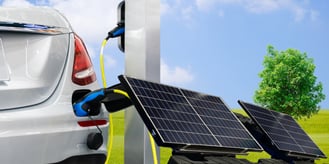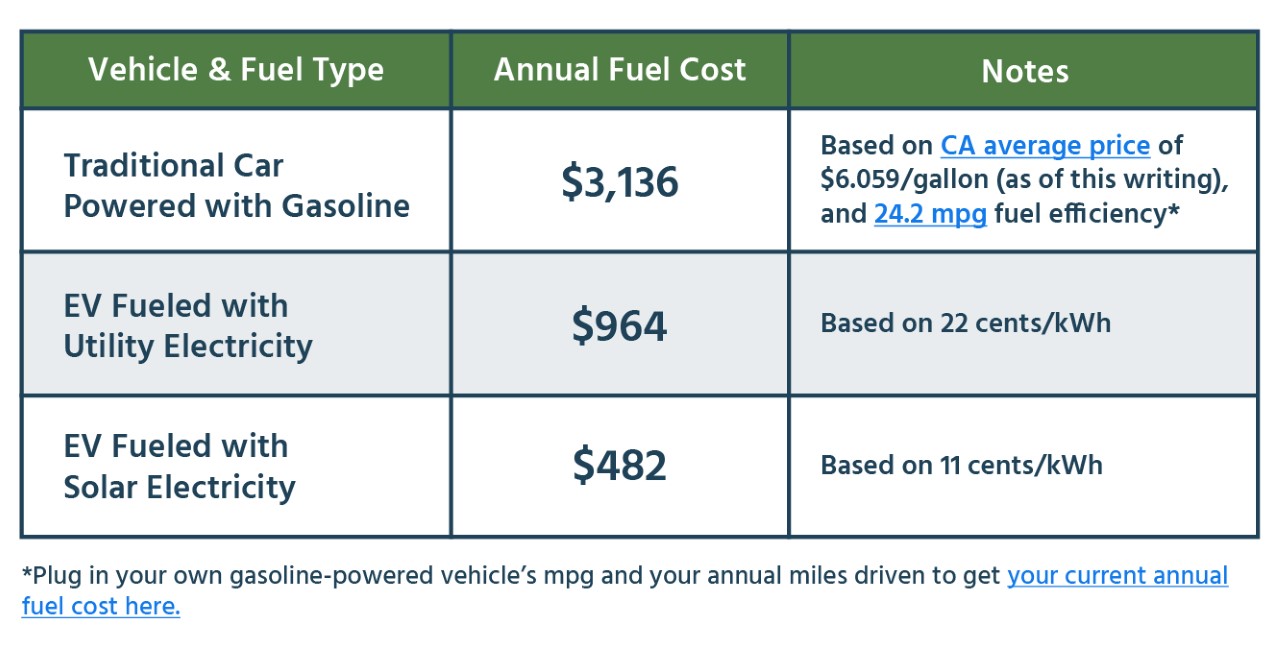Every time gas prices shoot up, more people ditch their gas-fueled cars and trucks and turn to electric vehicles (EV). Why? Because electricity is generally a cheaper fuel source than gasoline.
However, charging an EV with utility electricity produced by burning fossil fuels, which creates harmful emissions, means you’re not getting the full environmental benefit of switching to an EV. It also means you’re not saving as much as you could on your fuel costs.
The solution? Installing a solar energy system and using solar panels to charge your EV. Fueling your car with sunlight instead of gasoline benefits your community and the world as well as your pocketbook and your peace of mind.
Read on as we explore:
- - What types of EVs and incentives are offered today
- - What it costs to charge an EV with traditional electricity
- - What it costs to charge an EV with solar electricity
- - How EV fuel costs compare to gasoline-powered vehicles
- - The environmental impact of switching to an EV
- - How to determine how many solar panels you need to charge an EV
- - How long it takes to charge an EV with solar
- - Integrating solar and EV charging technologies
- - How to choose between solar and an EV if you can’t do both at once
- - What type of EV charger you need.
What EVs and incentives are available today?
Environmentally friendly car options have expanded considerably since Toyota introduced the Prius hybrid 25 years ago, and Tesla launched its high-end, all-electric models in 2008. Today, all the major automobile manufacturers are developing hybrids, plug-in hybrids and/or EVs. And EV models are getting bigger (think SUVs from brands including Toyota and Chevrolet, and the Rivian pickup truck), making them more realistic for bigger families.
Recently, President Biden signed the Inflation Reduction Act into law. The “IRA” includes a $7,500 tax credit for new EV purchases, and up to $4,000 for used EVs, making electric vehicles more affordable than ever. (There are conditions to claim the tax credit as this article from the Electrification Coalition explains.)
What does it cost to charge an EV with traditional electricity?
The exact cost savings when you switch to an electric vehicle depend on factors like how much you drive and your regional fuel cost. Gas prices, of course, fluctuate constantly, making an exact prediction impossible. Don’t be frustrated by that. Think about your food budget: Milk and bread prices change over time making it difficult to predict the coming year’s grocery budget with absolute certainty. However, you can still make a really good estimate based on previous years. The same is true for your transportation costs when you switch from a gasoline-powered vehicle to an EV. Based on available data, you can make a good estimate.
We can comfortably predict that switching to an EV will likely lower your car ownership, fuel and transportation costs.
Let’s dig into the factors that affect the financial impact of switching to an EV, while giving you a typical example.
How much do you drive? According to the Federal Highway Administration (FHA), Californians drive on average 12,524 miles per year, or about 34.3 miles a day.
How much electricity do you need to charge an EV driving that much? A typical EV uses about 0.35 kwh of electricity to drive one mile, according to fueleconomy.gov. So at 12,524 miles per year, that’s 4,383 kWh needed per year to charge the EV.
What will that much electricity cost you from the utility? In California, the average electricity rate is more than 22 cents per kWh. The 4,383 kWh needed per year multiplied times 22 cents per kWh is more than $964 per year.
Here’s how you can get your specific cost:
- EVs have a rating that expresses the kWh needed to drive 100 miles. Find out that rating for your EV.

- Divide that by 100 to figure out how many kWh you need to drive one mile.
- Multiply that times the miles you expect to drive. The result is your approximate kWh needs.
- Multiply that times your local utility’s rate. Or just use the California average of 22 cents. The result is what it would cost you to fuel your EV.
Don’t want to do the math? As part of your solar evaluation, the energy professionals at Citadel can calculate this for you.
What does it cost to charge an EV with solar electricity?
You might be wondering if it’s cheaper to charge an EV with traditional or solar electricity. Since solar-powered electricity is almost always cheaper than utility electricity, it’s almost guaranteed you will save money if you charge your EV with solar instead of utility energy.
How much you save depends on the size of your EV’s battery, how much you drive, and the cost of your solar system. The cost of your solar system depends on which equipment you have installed and how solar-friendly your roof is.
How does an EV compare to a gas-powered car?
Here’s how the annual costs for the different options compare. We are still using the average annual mileage of 12,524, and 4,383 kWh to charge the batteries for that number of miles. For the solar cost, we’ll use $0.11 per kWh which is fairly typical based on a 25-year time frame. (Your actual cost per kWh if you go solar depends on variables we can explain in detail.)
Again, one of Citadel’s solar consultants can calculate the cost of charging your EV with solar, if you provide the EV model and your annual driving mileage.
What’s the environmental impact of switching to an EV?
The positive environmental impact of switching from a gas-powered car or truck to an EV is significant. According to National Geographic, vehicles produce about one-third of all air pollution in the U.S. But driving an EV produces no emissions whatsoever.
Annual pollutants emitted by a typical car include 4.6 metric tons of carbon dioxide (CO2). If that’s not bad enough, automobiles produce methane and nitrous oxide and sometimes hydrofluorocarbon, all of which have a “higher global warming potential than CO2” according to the U.S. Environmental Protection Agency (EPA).
Just imagine the collective impact if every single car in the country was an electric vehicle?
When you charge your EV with clean solar electricity, you do a lot to help the world fight climate change. An EV charged with dirty fossil-fueled electricity from the utility isn’t 100% non-polluting. An EV charged with sunlight, however, is a truly clean car (when it comes to operating the vehicle, that is; we can’t speak to how clean the inside or outside of your car is!).
How many solar panels do I need to charge my electric vehicle?
The numbers of solar panels needed to charge an EV depends on the size of the vehicle’s battery and the output of your solar energy panels. Solar output depends on a number of variables including panel efficiency, roof direction and slope, and weather.
Let’s make some conservative assumptions so we can calculate an example.
- We’ll assume you drive 12,524 miles a year, and that your EV uses 0.35 kWh of electricity to drive one mile, or 4,383 kWh for the entire year.

- We’ll assume your solar energy panels each have 350 watts of capacity. (Panels range from 350 to 430+ watts these days.)
- Each 350-watt panel might produce 511 kWh of solar electricity per year, according to this SolarReviews analysis.
- So, 9 solar panels that produce a total of 4,599 kWh of electricity per year would be enough to generate the 4,383 kWh you need to charge your EV for the year.
Of course, you’ll probably want to power your entire home with cost-effective solar, not just your EV. That will require more panels.
Let your Citadel solar consultant know the size of the EV battery you’re considering, or already own, and we’ll determine how many panels you need to charge your EV plus meet your other needs.
How long will it take to charge my EV with solar panels?
Charging your EV with solar panels will take as much time as it would with traditional electricity, since charging time is based on the speed of the charger and the size of the EV battery.
Is it easy to integrate solar with an EV charger?
Yes, it is incredibly easy to set up your EV charger to be charged by your solar energy system.
The solar panels are installed as in any solar system. This generally entails attaching a racking system to your roof (or on your land), and attaching panels to that racking. Inverters are installed to convert your solar electricity into AC for use in your home, and the entire system is wired.
The EV charger is installed in a convenient location, typically the garage.
Both the solar system and the EV charger will require breakers in your main electrical panel, so if you don’t have any available, a panel upgrade would likely be needed.
What if I can only afford solar or an EV now – which do I get first?
There is no right or wrong answer here. It depends on your budget and your needs.
If you install the solar first, you’ll benefit right away from lower electric bills along with reduced pollution, some independence from the utility, and increased property value. So if lowering your household budget is your priority, you may opt for solar first. In fact, the savings on your electricity can help you save up for your EV. Or, put your solar savings toward the monthly payments if you get an EV through a lease or with a loan.
Just be sure to tell your solar installation company that you plan to get an EV in the future. (And any reputable installer should ask about your future needs when they design and price out your system.)
If you drive a lot and want to get away from fossil fuels ASAP, you might prefer to get your EV first. You’ll still save money on fuel. Later, when you add a solar energy system and start charging your EV with your solar panels, you’ll save even more on your transportation costs while reducing pollution.
What type of EV charger do I need?
A major factor in how quickly your EV battery will charge is the type of charger you use. Chargers come in three “strengths” as determined by engineering organization SAE International.
Level 1 is the slowest charger, using a standard 120-volt household outlet and taking more than a day to fully charge an EV. It isn’t practical for most people.
Level 2 is the most common charger in use today. It requires a 240-volt outlet and is often professionally installed although some DIY’ers can do it themselves. These charge most EVs in a matter of hours. Many public EV charging stations offer Level 2 chargers.
DC Fast Charging is the fastest option. It uses direct current (DC) versus the alternating current (AC) used by the Level 1 and Level 2 chargers. As the name implies, these chargers can fully charge an EV battery faster than the other options, in a matter of minutes sometimes. So if you’re on a long trip, you can top up your battery while you have a quick lunch.
The Tesla Supercharger is a DC fast charger. If you buy a new EV, it will probably come with DC fast-charging capability. But not all used EVs have this capability.
This How-To Geek article digs into EV charger technology in more detail.
What do I do next?
We’ve thrown a lot at you. Hopefully the reasons we’ve given and the variables we’ve listed make it clear what factors impact your EV charging costs, and how big a solar energy system you would need to charge that EV.
Learn more on this topic by clicking on any of the links in this article, or by contacting Citadel Roofing & Solar to speak with an energy pro. You can also learn more about these related topics on our website and blog:
- How to Size a Solar Electric System
- How to Pay for Home Solar or Energy Storage
- The Environmental and Health Benefits of Solar Energy




